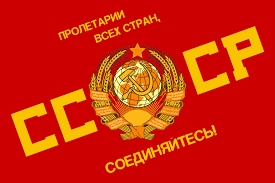“From the ashes of humanity, we will rise.” These were the final words spoken by the remnants of the Russian government before the last radio transmission faded into silence. As the message echoed through the survivors seeking refuge in the metro, it struck a deep chord with many on the Sokolnicheskaya Line. Fueled by resentment toward the oppressive fascist bureaucracies that had taken hold in the surviving stations, they rose in defiance. Revolts erupted, and revolutionary councils formed, determined to restore communism and rebuild a new order from the ruins.
For more info, go here
https://metrovideogame.fandom.com/wiki/Red_Line
| National Factbook |
| Flag: |

|
| Nation Name: |
The Red Line |
| Leader Name: |
Maxim Moskvin |
| Currency: |

Mil-Grade Bullets |
| National Animal: |

Bear |
| History: |
Sokolnicheskaya was built for much the same purpose as the palaces (or tombs) of the ancient Pharaohs. A testament to the glory of the Soviet state, and the power of Stalin himself. On every wall and edifice, sumptuous statues were sculpted and mosaics laid, and while now stained by soot or decayed by the passing of time, the name remained, and so did the aura of Soviet majesty. It was this aura which attracted to the line everyone nostalgic for the socialist past and saw in the new world an opportunity to build a communistic utopia; like pilgrims journeying to visit the relics of a long-dead saint, surviving believers in the socialist dream congregated in the stations of Sokol, and bided their time. Following the collapse of Central Metro Command a few years after the destruction of the surface, Communist agitators throughout the Red Line began to bring their work to fruition. All across the Red Line, Muscovites overthrew their administrations and established revolutionary councils. Once enough station governments had been overthrown, the masterminds of the revolution declared a first "Interstational", with the goal of uniting the entire metro and establishing true Communism for all time. (Numerous parallels can be made between the USSR and the Red Line; this is especially true of its history. The Interstational Period can be compared to the Russian civil war and the attempt to spread Communism into Poland, Finland, and the Baltic States. There are also parallels with the theory, embraced by Trotsky, that Communism had to occur on a global scale to succeed.) Following the conquest of almost the entire Sokol Branch, the Red Line seemed on the verge of taking over the entire metro and establishing a universal pseudo-Soviet state. However, many remained in the Metro who opposed this potentiality on both ideological and more practical grounds. As the Communists prepared to strike at these stations and bring to fruit the long-awaited workers revolution, a coalition of stations led by Hanza, which viewed the revolution as a threat to its economic interests and territorial integrity, similarly readied itself.
When the Hansa-Red Line War was finally sparked by the CCCP-to-be, the anti-comintern coalition was prepared. What should have been a short war according to both sides evolved into a bloody stalemate, sucking in precious men and material which could have improved life for the people of the Metro and gone into preserving what remained of civilization. As the war dragged on, mutinies and desertions on the front, coupled with growing unrest in the home stations, forced the two parties to reach an agreement. Ploshchad Revolyutsii, right below Red Square and all the decaying monuments of Soviet glory long since past, was ceded to the Reds from the Arbat Confederation, and Arbat received the Biblioteka Imeni Lenina station (later ceded to Polis). A guarantee of free transit was made by both parties (on which the Red Line, now cut in half, was dependent). With both parties satisfied, the way was paved for a relationship of mutual economic dependency and watchful ambivalence. |
| Geography |
| Continent: |
Europe |
| Land Area: |
40,153.03 sq. km |
| Terrain: |
|
| Highest Peak: |
,
0 meters
|
| Lowest Valley: |
,
0 meters
|
| Climate: |
|
| People & Society |
| Population: |
1,231,197 people |
| Demonym: |
|
| Demonym Plural: |
|
| Ethnic Groups: |
- 0.0% |
| Languages: |
- 0.0% |
| Religions: |
- 0.0% |
| Health |
| Life Expectancy: |
0 years |
| Obesity: |
0% |
| Alcohol Users: |
0% |
| Tobacco Users: |
0% |
| Cannabis Users: |
0% |
| Hard Drug Users: |
0% |
| Economy |
| Description: |
The Red Line's state ideology is a far-left mixture of Trotskyism and Stalinism. They claim to promote class equality, common ownership, and anti-capitalism. On paper, the Red Liners believe that everything that comes out of their labour is to be shared equally with everyone, meaning all are entitled to food, water, and housing. Their society, as noted by Pavel Morozov, follows a very strict mindset: one leader, one party, and one ideology to assure that their ideological goals are met. Pavel mentions order and control being considered more important than individual freedoms, to make sure their beliefs withstand. In reality, life on the Red Line stations is tough for most residents, with a brutal police-state system of government and frequent shortages of food or other necessities - citizens are often overworked, underpaid, and generally terrorized by the government. Well-armed soldiers patrol each station under communist control to maintain law and order as well as prevent rebellion, while conscripted recruits are used for war fighting at the front. According to Khan, individuals commonly sell out their own neighbours to the police, supposedly for rewards of food. Those who do so much as disrespect a soldier or are simply in the wrong place at the wrong time, are arrested and sent to Lubyanka station located underneath the old KGB (Soviet Union's secret police) headquarters, which is used as a political prison by the Communists for citizens who break the law or do not obey the government. A common phrase used in regards to Lubyanka station is that "the ticket to Lubyanka is always one-way", hinting that all who go there are worked/tortured to death or outright executed. These rules and policies cause large numbers of refugees to flee the Red Line, creating a refugee crisis for the other factions, although most don't make it that far. |
| Average Yearly Income: |
$87.88 |
| Gross Domestic Product (GDP): |
$2,839,302,077.00 |
| GDP per Capita: |
$2,306.13 |
| Gross National Income (GNI): |
$2,213,697,990.00 |
| Industries: |
|
| Military |
| History: |
The majority of front-line soldiers of the Red Army are poorly trained and equipped conscripts fresh from the stations, usually being armed only with a Bastard carbine, single magazine (which is also their conscription payment), and a non-protective cloth uniform. This is because these soldiers are commonly used as cannon fodder by their commanders or as a human wall for protecting emplacements during the major combat with the Fourth Reich, often being slaughtered with ease by the more superior Nazi soldiers. Despite this, many Communist soldiers can be seen wearing professional combat armour and metal helmets, as well as being armed with Kalashes, some also featuring night vision goggles. These soldiers can be seen in the levels "Armory" acting as security forces, and "Frontline" just hanging around, either talking to other soldiers or patrolling. Judging by the fact that these well-armed soldiers are always a distance away from the frontline, it could be assumed that they are either officers/squad commanders or elite special units either on par with Nazi soldiers or even better, to be sent into battle when the conscripts are not effective or are low in numbers.
The Red Army, the official military of the Red Line, and is believed to be the largest army in the Metro. When comparing it to the military of the Fourth Reich, the Red Army is much larger in size due to the Red Line having a much higher population to conscript from, and because of this they also have lower standards towards the combat capability of their troops. Internal politics of Communist controlled stations are focused upon conscription, aimed at enticing as many recruits to join up as possible. Therefore, they have the manpower to launch costly human wave attacks against the Nazi defenses without so much as a second thought, which in itself is based on ahistorical movies and biased sources. Red Army soldiers are mostly untrained, poorly equipped, and sent into battle shortly after recruitment. The methods of how soldiers are recruited and criteria to be considered suitable for combat are never explained. It can be assumed, however, that while they are not forced to be soldiers, all able-bodied males are pressured into signing up due to the apparent poor quality of life in Communist-held stations. Soldiers are promised payment of one full clip of bullets for fighting but are pressured into spending their pay to fight the enemy. |
| Soldiers: |
0 |
| Tanks: |
0 |
| Aircraft: |
0 |
| Ships: |
0 |
| Missiles: |
0 |
| Nuclear Weapons: |
0 |
| Last Updated: 03/17/2025 12:55 am |


















